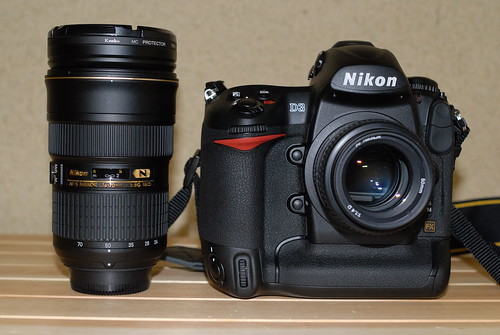
Ever since the simultaneous announcement of the Nikon D1H and D1X back in 2001 Nikon's professional D 'single digit' series has been split into two - the X series designed for high resolution applications such as fashion or landscape photography and the H series for high speed sports type photography (lower resolution but faster continuous shooting). When the Nikon D3 was announced in August 2007 it did not carry an 'H' in its name but was clearly designed for speed. So the question wasn't if, but when, Nikon would launch a high-resolution counterpart. It arrived, after more than a year of eager anticipation, in the shape of the Nikon D3X in December 2008.
Superficially, the new flagship is the D3's identical twin. The body, controls, user interface and also a large proportion of the camera's electronic and mechanical innards have been carried over directly from the D3. The camera's core component, however, is brand new. The 36 x 23.9 mm CMOS sensor provides a resolution of 24.5 megapixels, and while this is - compared to the D3 - a massive jump in resolution, D3X users have to accept a smaller range of sensitivity (ISO 100 to 1600, extendable to ISO 50 to 6400) and slower continuous shooting of five frames per second (7 fps in DX mode) in return.
While the only other piece of news - the 'Extra High' setting for Active D-Lighting - won't make much difference for most users, the premium that Nikon is charging for the extra resolution most certainly will. For $8000 retail price you can bag yourself almost two D3s. The D3X is also roughly $1500 more expensive than its only real competitor in terms of specification and features, the Canon EOS 1Ds Mark III. This won't make the professionals who this cameras is targeted at contemplate changing systems, but can a camera be worth the equivalent amount of a small car? Read on and find out in our in-depth review of the Nikon D3X.
24.5 megapixel Full-Frame (36 x 24 mm) sensor
ISO 100 - 1600 (ISO 50 - 6400 in Boost mode)
Also supports DX lenses, viewfinder automatically masks (10.5 megapixels with DX lens)
14-bit A/D conversion, 12 channel readout
Gapless micro lens array and on-chip noise reduction
Nikon EXPEED image processor (Capture NX processing and NR algorithms, optimized for D3X, lower power)
Super fast operation (power-up 12 ms, shutter lag 41 ms, black-out 74 ms)
Kevlar / carbon fibre composite shutter with 300,000 exposure durability
Multi-CAM3500FX Auto Focus sensor (51-point, 15 cross-type, more vertical coverage)
Auto-focus tracking by color (using information from 1005-pixel AE sensor)
Auto-focus calibration (fine-tuning) available (fixed body or up to 20 separate lens settings)
Scene Recognition System (uses AE sensor, AF sensor)
Seven frames per second in continuous and DX mode
Dual Compact Flash card slots (overflow, back-up, RAW on 1 / JPEG on 2, copy)
Compact Flash UDMA support
3.0" 922,000 pixel LCD monitor
Live View with either phase detect (mirror up/down) or contrast detect Auto Focus
Virtual horizon indicates if camera is level (like an aircraft cockpit display)
HDMI HD video output
'Active D-Lighting' with new 'Extra High' setting (adjusts metering as well as applying D-Lighting curve)
Detailed 'Control Panel' type display on LCD monitor, changes color in darkness
Buttons sealed against moisture
Dual battery charger as standard
No comments:
Post a Comment